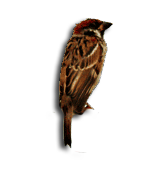General Characteristics:
- There are several species of sparrows throughout North America
- The House Sparrow measures about 4-6 inches in length and weighs about 1 ounce, quite small in comparison to other bird species
- Stout bird with short legs and a thicker bill than its relatives
- Both sexes are brown with black streaks and have light coloured undersides
- Males have white cheeks and a black bib which is not found on the females
- Sparrows are primarily seed eaters, however in urban areas will readily accept many food types from people
Reproduction:
- These birds are prolific breeders with up to 4 clutches per season
- Nests are built from February to May in and on trees and structures
- Mating pairs are monogamous for the year
- 1-8 eggs hatch in 11-17 days
- A high natural mortality rate exists for Adult sparrows between 40%-60%annually.
Signs of Infestation:
- Found widespread throughout residential, commercial, warehouse, animal zoos, stadiums, airports, etc…
- Flocks of sparrows can be a serious nuisance
- In rural areas livestock and feed can be consumed and contaminated
- They will displace nesting areas of smaller songbirds in any area
Control Techniques:
Several methods are available for nuisance problems you may be experiencing:
- Exclusion of all attractive nesting sites on and around structure. Sealing all cracks and openings in structure can be helpful
- Netting is effective and commonly used in receiving areas, overheads, building entry/exit points etc…
- Broken windows in upper areas of buildings should be sealed
- Spaces between air conditioners and building should be sealed
- Building rooftop ventilators should have netting overtop to prevent birds from nesting
- Large warehouse entrances used for forklift operation can be blocked from birds using hanging clear plastic strips. This allows the day to day operations to continue while deterring a variety of bird species
Please click here to contact a Focus Pest Control professional to inquire about further treatments for this pest species.
References:
Benett, Gary W., et.al.. Truman’s Scientific Guide to Pest Control Operations. Duluth: Advanstar
Communications, 1988. Pp. 337-351.
Roof, J. 2001. "Passer domesticus" (On-line), Animal Diversity Web. Accessed May 15, 2009 at http://animaldiversity.ummz.umich.edu/site/accounts/information/Passer_domesticus.html.
Disclaimer:
The Focus Pest Control ‘Pest Library’ is an educational resource written largely to educate the general public about common pests in Ontario. The Focus ‘Pest Library’ does not include all species in Ontario, nor does it include the most recent scientific data about species we describe. Though we edit our accounts for accuracy, we cannot guarantee all information in those accounts. While Focus Pest Control staff and contributors provide references to books and websites that we believe are reputable, we cannot necessarily endorse the contents of references beyond our control.
(Back to top)
|


